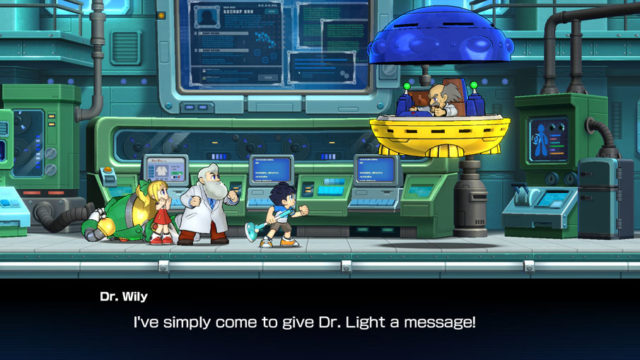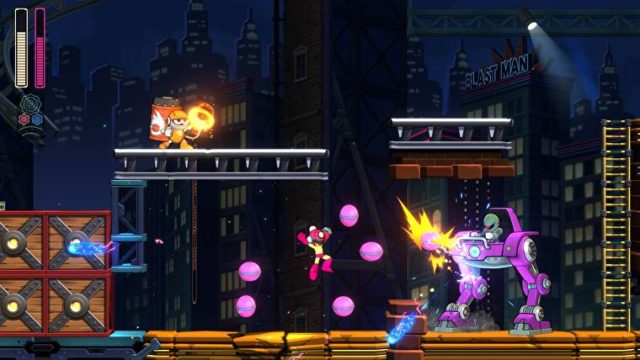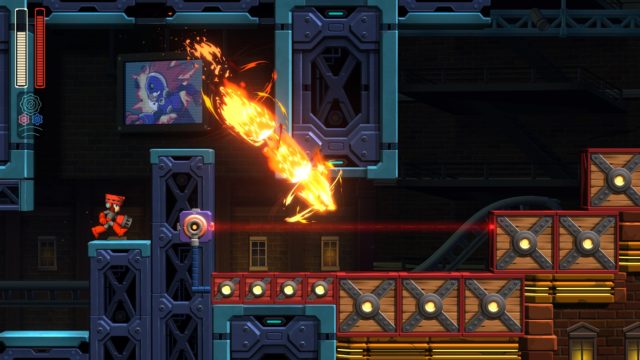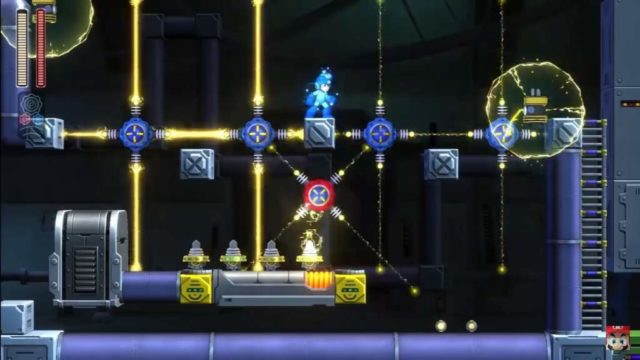Incredible reinvention of the series that sticks to its roots while also moving the franchise forward; stunning visuals capture the charm of yore; tight gameplay; Double Gear System is fun and will help newer players; variable difficulty levels caters to players of all skill levels; tons of replayability
Soundtrack is good but somewhat unremarkable; Double Gear System is ultimately not necessary and can almost be entirely ignored throughout the campaign
Much has been said about how Mega Man 11 is the first new installment in the series since 2010’s Mega Man 10, but the truth is that it’s been far longer than eight years since Capcom has been this experimental with the Blue Bomber. To really appreciate what this means, let’s turn the clock back to 1997 and Mega Man 8 on the original PlayStation. Mega Man 8 is generally seen as a divisive entry, but there’s no denying that Capcom wasn’t playing it safe with that game. Mega Man could use multiple weapons at once, upgrade his gear using a limited number of power-up slots, and could even swim!
When Mega Man 9 came around in 2008, 11 years after 8 had hit stores, it was very warmly received for going back to the series’ roots. In a classic example of adding via subtraction, Mega Man 9 boldly returned to the NES days of the franchise by employing 8-bit graphics, chiptunes, and even removed mechanics like Rock’s slide and charge shot to get things truly back to basics. At the time, it felt like a breath of fresh air for a series that had become encumbered by the weight of its own excesses. Yet, despite essentially being reborn with Mega Man 9 and 10, the series has languished for another eight years following the split between Capcom and Mega Man co-creator Keiji Infaune.
During that time, a number of spiritual successors have arisen to try and fill the void left behind by Rock and company, including the delightful Azure Striker Gunvolt series and the woefully disappointing Mighty No. 9 (ironically created by Inafune himself). With Mega Man 11, Capcom has officially dusted the franchise off for a new generation of players, but as opposed to being reductive to move things forward, this time around the developer has decided to once again push Mega Man to the bleeding edge rather than embrace his pixelated roots. The result is a wonderful mix of old and new that provides fans an experience that perfectly encapsulates everything there is to love about the Blue Bomber.

Things start off with the revelation that Dr. Wily and Dr. Light had a falling out while in college that resulted in the former being forced to give up on an experimental technology deemed too dangerous (Reed Richards and Victor Von Doom, anyone?). Considering Wily’s propensity for life-threatening tech it’s not too big of a surprise, but what’s particularly fascinating about this revelation is that the nefarious doctor’s “Double Gear System” ends up proving to be an invaluable tool to Mega Man himself this time around. Dr. Light has been holding on to Wily’s banned technology for all these years and, when his old foe gets back up to his usual tricks, decides to modify it and merge it into Mega Man’s own suite of abilities to make him more formidable than ever. As far as narratives go, Mega Man 11 has the perfect balance between what the NES entries and the Mega Man X series had to offer.
The Double Gear System is a fascinating new mechanic that isn’t a bad addition by any means, but felt more superfluous than groundbreaking over the course of the game. Essentially, the Double Gear System allows for two different enhancements during gameplay: Speed Gear makes Mega Man move so fast that it appears everything around him is in slow motion, while Power Gear increases the strength of his shots. Both of these augmentations can be used at the same time, turning Rock into a veritable battering ram, but note that a meter runs down as the gears are engaged and will overheat if the player isn’t careful, thus balancing the new mechanics out quite nicely. The Double Gear System is fun, but nonetheless comes across as perfunctory. Sure, some enemy engagements revolve around mastering it (Yellow Devils are a great example of this), but at the end of the day, it never felt truly natural or necessary to ever call upon the Double Gear System. I’ll concede that most folks will likely enjoy it, but I personally didn’t get much from the new system.
Still, it speaks to Capcom’s vision for Mega Man 11 that the Double Gear System even exists. Capcom truly went all-out for this game, looking at the elements of the series that work and sticking with them while also pushing other bits in different directions to bring the Blue Bomber more firmly into the modern era of gaming. Let’s be fair, here: sometimes I think people lose sight of the fact that Mega Man is more than capable of taking on multiple interpretations. Mega Man X, Mega Man Legends, Mega Man NT Warrior, Mega Man Zero, Mega Man Soccer (I jest), all of these different titles and series have existed over the years, sometimes at the same time as one another, and Rock has never suffered from it. Indeed, the franchise is all the richer for having this wealth of gameplay and story diversity.
With Mega Man 11, it’s just another take; another interpretation that eschews some of the familiar trappings for new ones. Visually, the pixels are out, replaced instead with beautiful 2.5D graphics (which are somewhat reminiscent of Mega Man Network Transmission on GameCube!). Unlike Mega Man 7 and 8, however, Rock’s movement feels much more in line with what fans are accustomed to from his NES days. It’s not perfect parity, but overall I felt like Capcom was able to modernize the visuals and maintain a familiarity to the mechanics akin to what Nintendo has done with the New Super Mario Bros. series. Plus, I thought the Mega Buster just felt great during my time with the game, bursting through foes with some very satisfying feedback.
Mega Man 11 might have some of the best enemy and character designs this series has seen in a long time. In Acid Man’s stage, for instance, there are enemies called Pipettos that are basically mobile syringes. As they scurry around the ground, the Pipettos lob blobs of chemicals into the air that land in the pools of liquid at Rock’s feet. When enough shots of these chemicals hit their mark, they increase the acidity of the fluid until it becomes deadly to touch. The brilliance of the design that went into these and other baddies throughout Mega Man 11 should be lost on no one, as it’s some of the best yet seen in any Mega Man title. While I can admit that the old school pixelated graphics have an undeniable charm, it’s a charm that doesn’t take away from what’s on offer here. The only blemish to Mega Man 11‘s presentation comes from a serviceable-but-unspectacular soundtrack that dumps chiptunes for an EDM style of music. It fits but isn’t especially memorable.

The Robot Masters, meanwhile, are perhaps not quite the best that the series has ever offered, but they’re an intriguing bunch with a nice mix of abilities and origins. Plus, they’re tough as nails, with some really tricky movements and attack patterns to try and pick up on in each encounter. As ever, Mega Man harvests the weapons from these bosses as he takes them down, and there’s also a certain rotation by which Rock can cycle through the bosses in order to best take advantage of each one’s particular weakness. This cycle remains one of the best gameplay hooks in all of video games and, thankfully, Capcom didn’t muck with it. If you’ve never gotten the chance to experience these hallmarks of the Mega Man series, this is them at their best.
Speaking of the difficulty level, Mega Man 11 is going to kick most people’s butts. This is a hard game, unabashedly so, and is yet another testament to what makes Mega Man so special. Your teeth absolutely should be getting kicked in when playing a Mega Man game. The challenge here is high, but it’s also fair. For one thing, the Double Gear System adds that extra bit of help that average players might need to handle the game on its normal and above difficulty levels. There’s also the usual smattering of bolts to be found throughout each stage that can then be used to purchase everything from E-Tanks to permanent upgrades to the Double Gear System itself, like reduced cool time. All of which can be ignored by players if they so choose if they want a more traditional Mega Man experience.

For those who do need the help, however, I think a perfect balance has been struck here. Mega Man arguably becomes overpowered once all of the available upgrades have been purchased, but it’s a small gripe, especially considering the upgrades aren’t even required to begin with. What’s more, there are also easy and casual modes available that massively reduce the difficulty, even going so far as to eliminate the instant deaths that touching spikes and falling down pits normally cause. Purists will most likely avoid these modes like the plague, but they’re there for those who need the assist. I personally think they’re a great way for newbies to acclimate to Mega Man’s gameplay and hope that those who choose to play these modes eventually try to play the game at a higher difficulty level once they become comfortable.
There’s a ton of replay value here in the form of Mega Man 11‘s myriad of extras. There’s an in-game achievements system, for starters, which tasks players with completing certain objectives under various conditions. Beyond that, there’s also a Challenges section where things get even spicier. The game can get crazy in Challenges, where stages are modified and anything can happen— enemies are replaced with balloons, Mega Man has to try to jump as little as possible, and so on. All of this is tracked via an online leaderboard, so players are able to monitor their standing on the world stage.

There’s also a new Mega Man Amiibo that can be used in Mega Man 11 (alongside the original and gold Mega Man Amiibo variants from a couple years back). Scan one into the game once a day and Mega Man will be rewarded with an extra life. Scan any other Amiibo into the game once per day and Mega Man will be rewarded with a random power-up like an E-Tank. Note that while an Amiibo can only be scanned a single time per day, up to 20 Amiibo can be used within that 24-hour period (assuming you don’t cheat and mess with the system clock!). This all further softens up Mega Man 11‘s difficulty, but that’s mitigated by the fact that no one is required to use Amiibo to play the game, so, again, everyone wins!
Honestly, “everyone wins” should be the tagline for Mega Man 11. It’s a fantastic reinvention of the series that respects both new and longtime fans. Some might bemoan the art direction, but I walked away from Mega Man 11 very, very impressed. It’s a particularly stunning achievement given the amount of time that has passed since the last game and Inafune’s lack of involvement. This is one of the marquee releases on Nintendo Switch and I sincerely hope that all of you reading this give it some serious consideration for a purchase. Capcom has created the perfect foundation upon which to keep building Blue Bomber sequels and I hope that the next one comes a lot sooner than eight years from now!




 ShareThis
ShareThis





